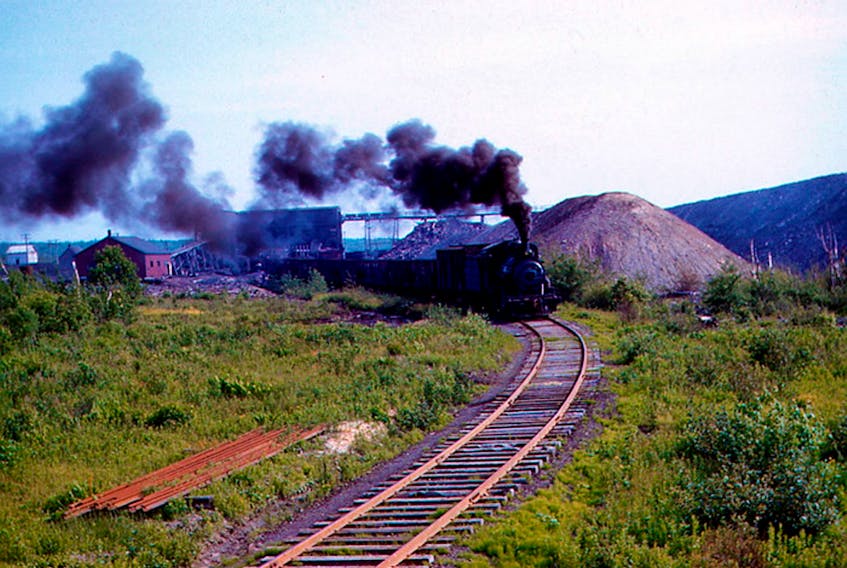JOGGINS – Dara Legere doesn’t consider himself a Joggins historian, but it’s hard to deny he has one of the most extensive collections around detailing the former town’s rich history.
Legere shared some of that history during a presentation at the Joggins Fossil Centre that was attended by more than a hundred people earlier this week during Heritage Day celebrations at the facility.
“It’s a project I really enjoyed working on and I enjoyed sharing it with people,” said Legere. “I have thumb drives and folders full of photos and it’s something that deserves to be out in the public. I’ve collected a lot of material over the last 40 years and it was great to get an opportunity to share it so others appreciate their community more.”
Joggins, he said, has had many challenges over the years including the loss of its coal mining industry and the railway in the early 1960s, a series of devastating fires in 1907, 1928 and 1947 and the loss of its status as a town in 1947 after going broke.
“In the end, they were paying their school teacher with groceries because the town had basically gone bankrupt,” he said. “Credit wasn’t available then like it is today.”
Despite these challenges – some of which could easily kill the spirit of community – Joggins remains a vibrant place as home of 300 million years of history in the fossil cliffs and increased tourist development through the UNESCO heritage designation for the cliffs.
Legere said he has always had an interest in the history of Joggins. He remembers walking on the beach, like many young people have over the years, and marveling at the numerous fossils in the cliffs. He developed a history of asking questions about the cliffs and the various buildings in the community while growing up. More than that, though, he began collecting photographs and newspaper clippings of the era when he grew up as well as from the time when coal mining was king in Joggins – as it was in much of northern Nova Scotia and Cape Breton.
While in Cape Breton several years ago, he saw a monument in Port Morien celebrating that community’s connection to coal mining in the 1700s in support of Fortress Louisbourg. Legere said coal mining in Joggins goes back at least to 1715, if not earlier as English miners mined coal from seams along the cliffs and shipped it to Annapolis Royal and New England.
Later, coal from Joggins would be used in homes and industries in Saint John, N.B. and later would be shipped by rail to Maccan to the Canada Electric power generating station.
In the boom and bust cycles of the industry, coal began to fall out of favour in the 1950s and the mines in and around Joggins would close in the early 1960s and the railway would disappear as well.
“After 1929 there were no mines within the town itself, they were all located outside the community,” Legere said. “There was no tax money coming in from the mines so it was only a matter of time before the town could no longer support itself.”
While it would’ve been easy for the community, which numbered 1,500 at its height, to disappear, Legere said it has remained and it’s something worth celebrating.
Legere, who is retired from Aliant, said Joggins had many of the attractions that larger communities like Amherst had in the late 1800s and early 1900s. Joggins, he said, was often in the U.S. newspapers because it was a source of coal for several America states in the northeast.
“There is a lot of documentation on Joggins, mainly because of the coal industry,” he said. “It also had a tremendous connection with Saint John. It was only 100 miles down the bay and Joggins was a tremendous source of cheap coal. Saint John merchants were very familiar with Joggins and played a role in developing the coal industry here.”
Following the First World War, a number of Belgians and Germans – displaced by four years of war – settled in the community to work in the coal mines and some of those surnames, such as VanSnick, have remained.
The town also hosted escape artist Harry Houdini and several Off Broadway productions.
“The railway was built to take the coal out, but it also brought a lot of interesting characters in. That’s why he played Joggins, the railway. There weren’t many places outside the major centres could do something like host Harry Houdini, but the line going into Joggins made it possible.”
Baseball also had a prominent role in Joggins’ history. Legere said baseball was king in many mining communities, like Springhill and Joggins, and several young men went on to make a name for themselves on baseball diamonds around the British Empire and the United Staties.
One of those was Wylie Devine, who pitched for the king and queen of England as a member of a Canadian military baseball team during the First World War.
There was also the Joggins Cubs ball team that won its share of Nova Scotia championships.
As much as it’s easy to be nostalgic of Joggins’ past, Legere said, the community has a future in the fossil centre and the cliffs that draw tourists and visitors from across North America and further to hear the story of Joggins and the cliffs.
“Every summer you go into the parking lot and you see cars from visitors from across Canada and the United States,” Legere said. “There are so many people coming in from away to learn about what took place at Joggins. It’s something we’ve known about for many years, but it’s also something a lot have taken for granted. It has really become an attraction for people outside the community to come to an actual UNESCO World Heritage Site. There aren’t too many of those around.”
Legere, who is also active with the Joggins branch of the Royal Canadian Legion, said his next project is to recognize 10 Joggins soldiers who were killed during the First World War but never made their way onto the cenotaph.
It’s something he hopes to have done in time for Nov. 11, marking the 100th anniversary of the end of the First World War.
Twitter: @ADNdarrell









